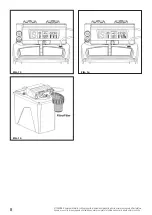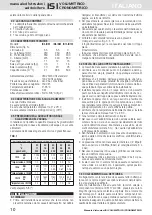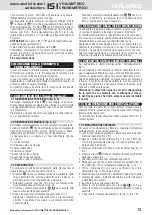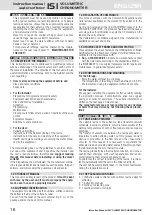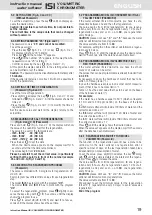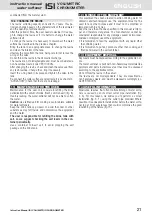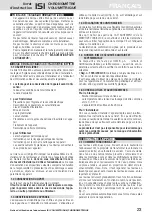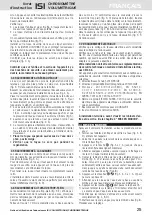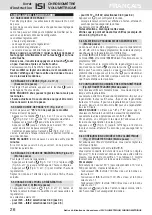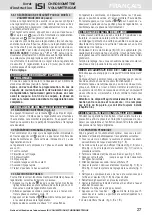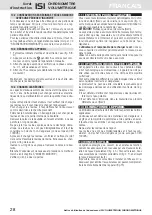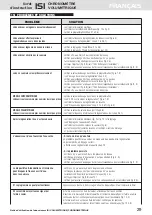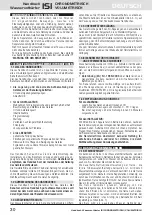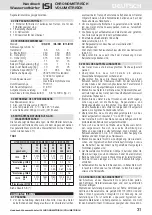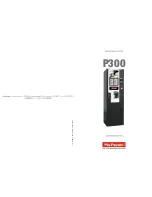
18
Istruction Manual ISI VOLUMETRIC/CHRONOMETER
from a reverse flow of hot water that could cause damage.
Install a tap to take a sample of the outlet water, to test its
hardness. All pipes must be free, not crushed or constricted
(fig. 4, A).
Check for the presence of hygienic security taps on the
entrance and exit of the equipment. Remove them only
during this phase and not before
.
3.4 CONNECTION TO THE DRAIN SYSTEM
Waste water resulting from the regeneration must be funneled
into the floor sink by the flexible pipe (fig.3, F) (included in the
package). Very often, the main cause for the water softener
malfunctioning is that this tube was not installed correctly.
(fig. 4, A)
Insert the drain pipe (fig. 3, F) in the rubber-holding joint and
place the other end of the tube in the floor sink, ensuring that:
• If the floor sink is placed higher than the water softener, the
maximum height acceptable is 1.8 metres, provided that
the pipe is not longer than 5 metres and the pressure of the
water system is at least 2.8 bar (fig. 5).
• The pipe is not flattened or bend, as water should flow wi-
thout obstacles (fig. 4, A);
• The drain pipe must never be directly connected to a si-
phon or to other drain pipes, to avoid reverse flows of water
and the contamination of the water softener.
•
Keep the drain pipe suspended over and not immer-
sed in the water of the sink
.
•
Ensure that the pipe does not come out when the wa-
ter softener is doing the regeneration
.
3.5 CONNECTION TO THE BRINE TANK
The valve is connected to the salt container by a pipe with a
diameter of 6 mm. Both the pipe ends are inserted into quick
joints (fig. 9, D).
To disconnect the pipe it is necessary to pull out the red secu-
rity clip, then press on the black ring that surrounds the pipe
next to the insertion, and extract the pipe.
To connect the tube safely, ensure that it is inserted all the
way in.
The installer must make sure the pipes and the joints con-
necting the valve and the brine are perfectly sealed, to avoid
air infiltration (fig. 9, D).
3.6 CONNECTION TO THE OVERFILL PROTECTION PIPE
The overflow pipe installation (fig. 3, E) allows for the draining
of possible excess of water that may be caused by faulty refills
or working malfunctions.
Drill a hole of 17 mm in diameter in the brine tank, around 10
cm under the lid and tighten the overfill protection quick joint
(fig. 3, H), Insert the green flexible pipe (included in the packa-
ge) in the quick joint, then connect the pipe to a floor sink that
must be placed under the quick joint beacuse the water that
may come out will not be pressurized (fig. 4, B).
Do not put the overfill protection pipe (fig. 3, E) in the same flo-
or sink used for the drain pipe (fig. 3, F) to prevent any possible
reverse flow of water in the brine tank.
3.7 CONNECTION TO THE ELECTRICITY GRID
Make sure that the voltage of the electricity grid is compatible
with the voltage needed by the equipment. Make sure that the
plug is compatible with the socket. If incompatible, let quali-
fied personnel change it. They will also check that the cables
are compatible with the absorbed power.
Installation must be carried out in accordance with the
law on electrical systems, CEI 64.8
.
This equipment was built in accordance with the essential
safety requirements set by the following European regulations:
• Low Voltage Directive 2014/35/UE
• The 2014/30/UE Electromagnetic Compatibility Directive
• Norme: 2014/30/EU/(EMC), EN 55014-1:2017,
E N 6 1 0 0 0 - 3 - 2 : 2 0 1 4 , E N 6 1 0 0 0 - 3 - 3 : 2 0 1 3 ,
E N 5 5 0 1 4 - 2 : 2 0 1 5 2 0 1 4 / 3 5 / E U ( L V D ) , E N
60335-1:2012+A11:2014+A13:2017
• Product norms IEC/EN 60335-1:2010 on the Electrical
safety of electrical machinery for domestic use and similar
• It uses UL/CSA/VDE homologated components
• It is RoHS compliant
After the installation is completed, before opening the
water inlet and outlet taps, read chapter 4 “ACTIVATION”.
4) ACTIVATION
After the installation is complete, follow the procedure below:
1. Close the water inlet and outlet taps (fig. 3, B, D), then
plug in the fixture.
2. Pour some water in the brine tank vat and cover the
suction pipe (Fig.1)
3. Press (Fig.6 e 7,A) until the display shows two hori-
zontal lines.
4. Wait for a few seconds, untill on the display appears
“C1”. Unplug the fixture.
5. Slowly open half inlet of water (fig. 3, D) and leave it in this
position for about 2 minutes, open the water inlet comple-
tely. Let the water flow abundantly until it is crystal clear;
open slowly the water outlet (Fig.3, B)
6. Press (Fig.6, A C and 7, A, C) to pass to step C2.
7. Wait till the water level in the vat decreases untill almost
all the water is sucked in.
8. Press to pass to step C3.
9. When the cycle is complete (it will take about 10 minutes),
check that the vat still contains some water.
10. Check that the inlet and outlet taps are completely open
(fig. 3, B, D).
11. Add salt, up to more than half of the vat (fig. 8).
Proceed with settings.
5) SETTING THE WATER SOFTENER
5.1 SETTING PASSWORD
The ISI softeners, require a password to set up the program.
The password will be asked everytime you want to re-program
the water softener.
Its function is to prevent the modification accidentaly in one or
more data of the programs.
The Data Programs of Water Softeners are:
- Time of Regeneration
- Measurements of Sale for Regeneration
- Number of Regenerations
- Volume of water for Softness
CAUTION: Some of the data to be visible/set needs to be
press key along with another key.
In this case press slightly in advance the key and than
the other key.
The Water Softener functioning will display the actual time.
To modify or set the data, you can feed the data’s simul-
taneously but only after each data you have to wait till
the display shows time
.
ENGLISH
instruction manual
VOLUMETRIC
water softener
ISI
CHRONOMETER





